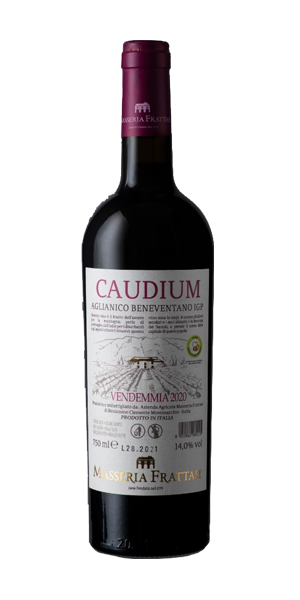Masseria Frattasi
Aglianico Beneventano Caudium
Aglianico is considered one of Italy’s three greatest red grapes along with Nebbiolo and Sangiovese. Aglianico is believed to be a very ancient indigenous wine grape landed in Southern Italy between the 8th and 7th century BC with the Greeks during the colonisation period. It is assumed that the name Aglianico has its roots in the word “Hellenic” which is a synonym for Greek. “Hellenico” might have become “Aglianico” between the end of the 15th and the beginning of the 16th century under the Spanish domination of Southern Italy. Some historians, however, do not support the hypothesis that Aglianico was one of the late ripening grapes mentioned by Latin writers and historians like Cato, Pliny the Elder and Columella that described in great details viticulture in northern Campania (Campania Felix) during the age of the Roman empire. They agree, instead, in a much more recent origin of the grape; according to them, the earliest the name Aglianico appears is in 1520 in an archival document attesting ownership of a vineyard.
The existence of many local biotypes of Aglianico indicates a large cultivation of this grape in Southern Italy. However, after the Phylloxera outbreak (that destroyed most of the vineyards for wine grapes in Europe in the late 19th century), this grape disappeared from many areas and it is today mainly found in the regions of Campania and Basilicata. The three most important biotypes that hold commercial relevance are: Aglianico di Taurasi (grown in mountainous areas of the Irpinia sub-region), Aglianico del Taburno (grown near Benevento in Northern Campania), and Aglianico del Vulture in the Basilicata region.
Aglianico is a late ripening grape usually harvested in October or early November. It performs particularly well in poor soils of volcanic origin that limit the plant vigour. It is therefore not just a coincidence if in the three most important areas of production, Taurasi, Taburno e Vulture, this grape is planted on volcanic soils.
Wines made from Aglianico are firm, savoury, with a mineral character and balsamic notes. Due to the high acidity level (tartaric acid) and tannins and its ability to age, fine Aglianicos have gained the reputation of the “Barolo of Southern Italy”. Interestingly, Aglianico wines show some aromas and flavours that recall the Nebbiolo grape; black cherry, violet, rose, red berries and liquorice. It was discovered, indeed, that certain organic molecules responsible for those aromas are present in both Nebbiolo and Aglianico wines.
Aglianico Caudium is made from grapes grown around Montesarchio, where Masseria Frattasi is situated, on the south side of the Mount Taburno. Caudium (modern Montesarchio) was the main city of the ancient Caudini local tribe that fought against the Romans during the city expansion. Montesarchio is one of the thirteen municipalities/villages associated with the Aglianico del Taburno. Here, diurnal temperature variations can be greater than in the other areas in Campania (i.e.Taurasi in Irpinia). The grapes benefit of a cooler microclimate and, for this reason, Aglianico wines from the Taburno show high levels of acidity and great freshness. In the south side of the Taburno, around Montesarchio, vines are planted at even higher altitudes than in other villages (the majority of which are located on the eastern side of the Mount Taburno). Masseria Frattasi sources the grapes that becomes Caudium Aglianico from vineyards around Montesarchio between four and five hundred metres above sea level, on clay and calcareous-rich soil. The wines therefore tend to have even higher acidity than the average of the Aglianico del Taburno wines. Aglianico Caudium is characterised by distinctive notes of tobacco and delicate herbal and underbrush notes which are typical of wines from this side of the mountain. Aglianico wines benefit from refinement in small oak as they can smooth their rough edges and tannins when young. Aglianico Caudium refines for around nine months in used French barriques.
The Aglianico vines of Masseria Frattasi grow on the slopes of the Mount Taburno (north of Naples) on volcanic soil at an altitude between 400 and 500 metres asl.
The grapes are harvested in November. After the fermentation and the malolactic fermentation, the wine refines for nine months in used French oak barriques.
Caudium is a smooth Aglianico with a savoury fruity aroma of blackberry, blueberries, and red plums jam twisted with balsamic and earthy notes. On the palate it is soft and pulpy with soft tannins.
Aglianico is a robust wine that require robust food. Due to the high acidity and tannins it pairs wonderfully with a number of rich meat dishes such as braised meat (Oxtail, Osso Bucco or Lamb Shanks) or game dishes like wild boar or duck. Also pasta dishes with rich meat ragu are a good match. When it comes to vegetables, it is important to match the savoury and earthy notes of the wine. Mushrooms and beans are ideal pairings. Among cheeses, salty cheeses like Parmigiano, Taleggio, Pecorino, Provolone or Manchego pair well.
Vintage: 2020
Grape: 100% Aglianico
Region: Campania
Alcohol (ABV): 14%
